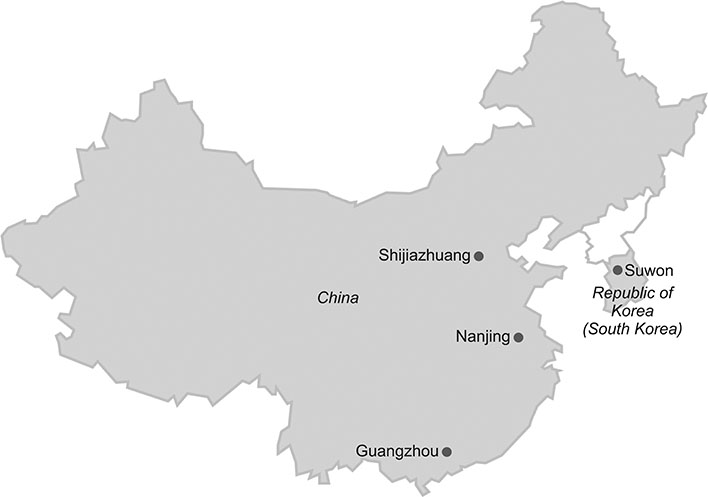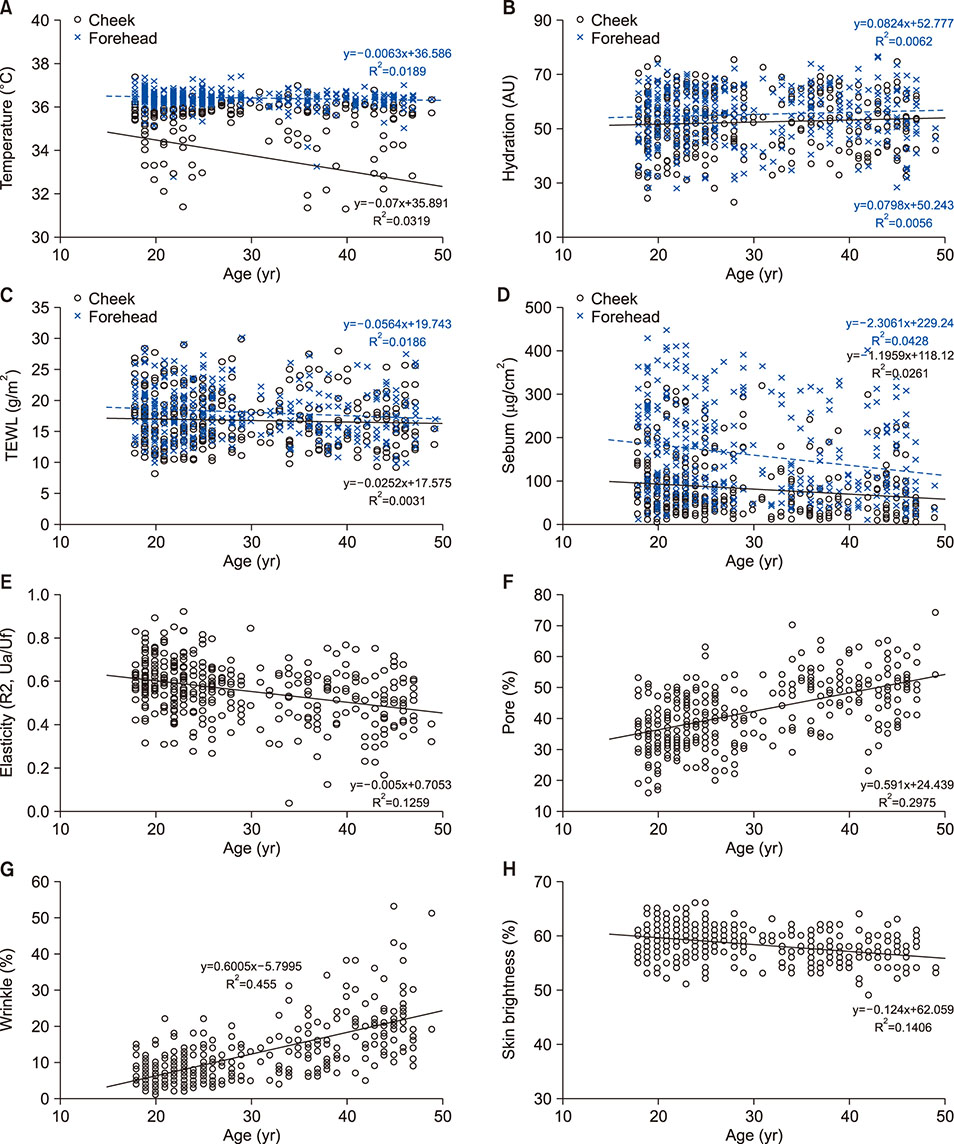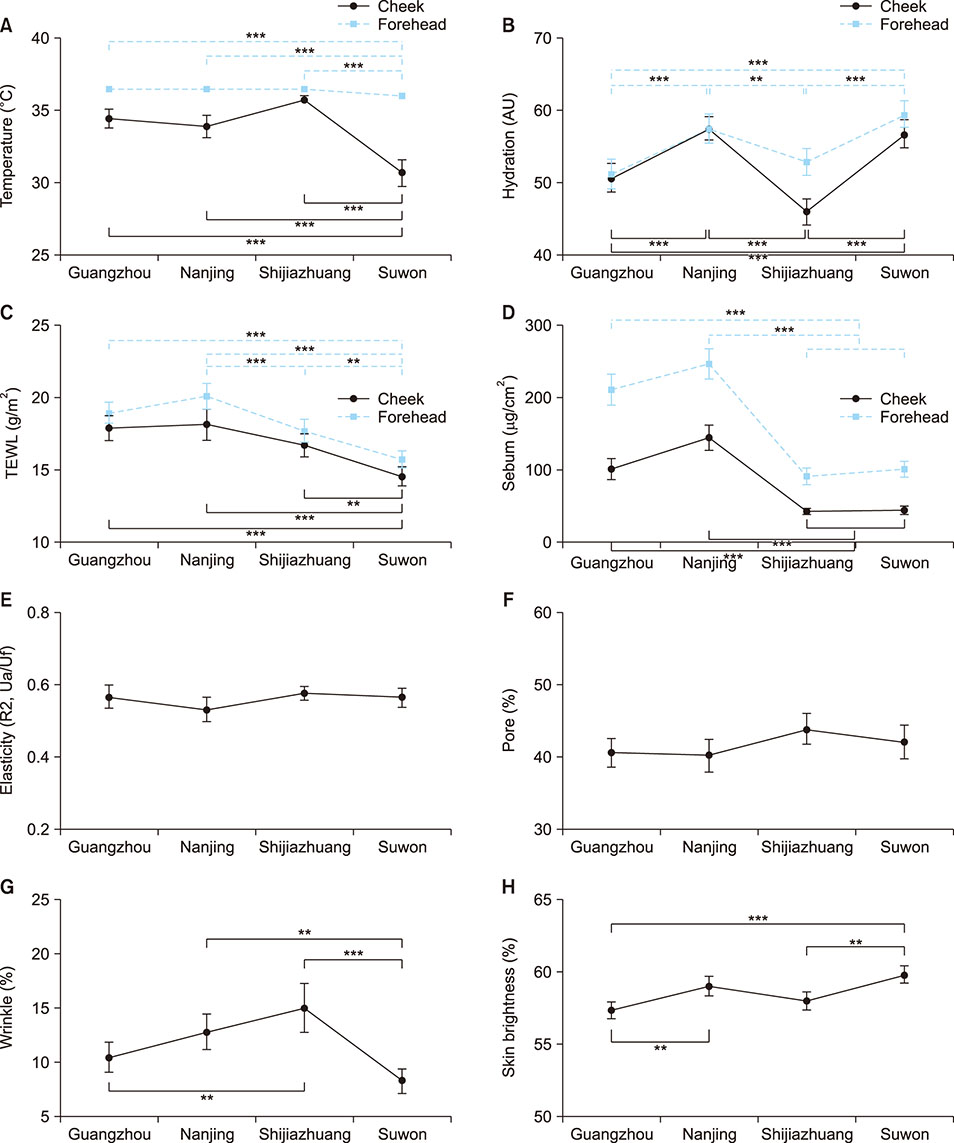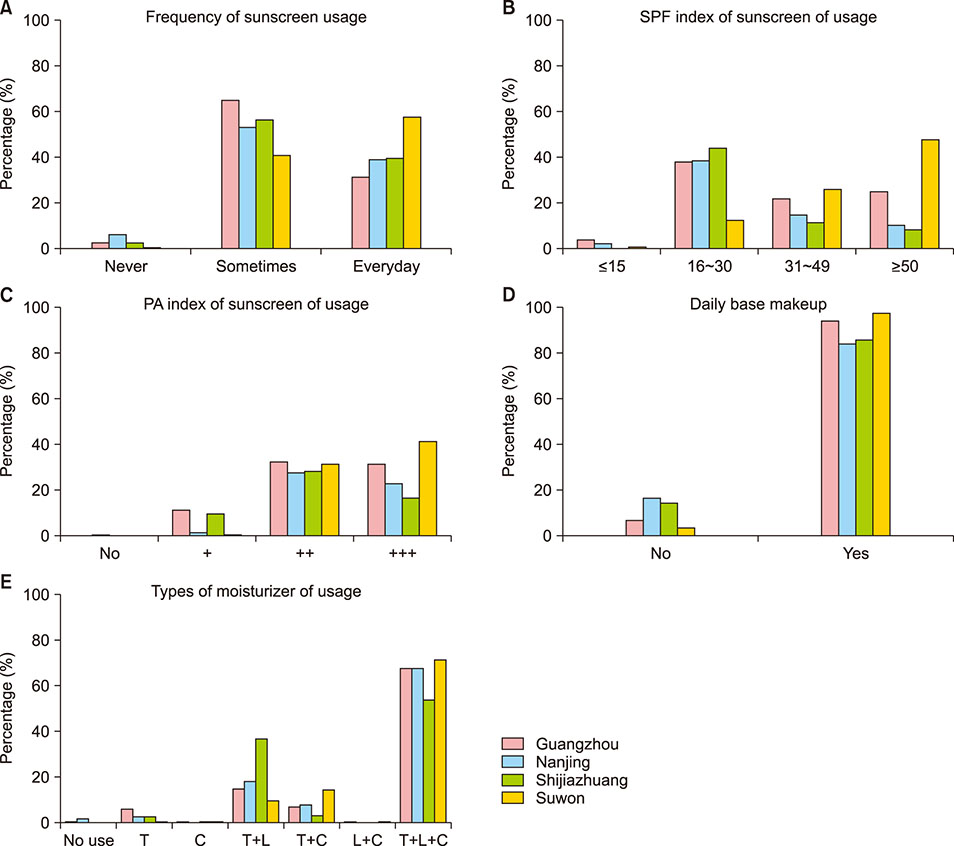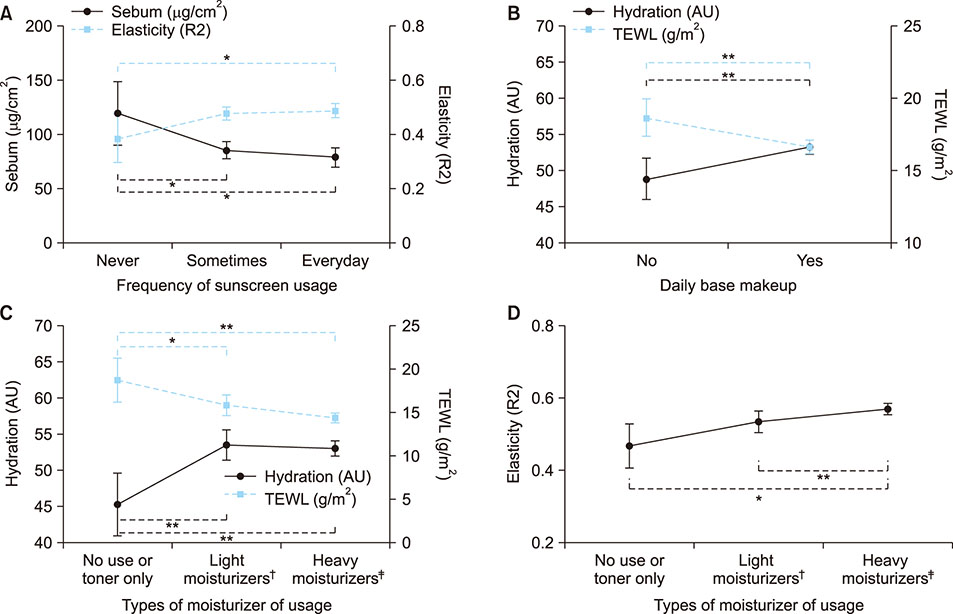Ann Dermatol.
2019 Apr;31(2):175-185. 10.5021/ad.2019.31.2.175.
Different Cosmetic Habits Can Affect the Biophysical Profile of Facial Skin: A Study of Korean and Chinese Women
- Affiliations
-
- 1Department of Dermatology, SMG-SNU Boramae Medical Center, Seoul, Korea. sycho@snu.ac.kr
- 2Skin Research Institute, IEC Korea, Suwon, Korea.
- 3Department of Beauty Coordination, Suwon Science College, Suwon, Korea.
- 4Smart Beauty Life Lab, SKIN79, Inc., Seoul, Korea.
- KMID: 2439063
- DOI: http://doi.org/10.5021/ad.2019.31.2.175
Abstract
- BACKGROUND
Previous studies on the age-, climate, and skin care habit-related changes of biophysical parameters have mainly focused on Caucasians, and studies on Asians are in paucity.
OBJECTIVE
This study was aimed to investigate the variations of cutaneous biophysical parameters in Chinese and Korean women (northeast Asians) and to assess the association between those parameters and age, climate, and cosmetic habits.
METHODS
A cross-sectional study included 361 healthy Chinese and Korean women between 18 and 49 years of age in 4 cities (Guangzhou, Nanjing, and Shijiazhuang in China, and Suwon in Korea). We measured skin surface temperature, hydration, transepidermal water loss (TEWL), sebum, elasticity, skin pore, wrinkle, and skin tone (brightness) using non-invasive instruments. Demographic profiles and cosmetic habits were assessed using a questionnaire.
RESULTS
Skin elasticity and tone decreased, and pore size and wrinkle increased with age. Subjects in Suwon (Korean) showed higher hydration level, lower TEWL and lower sebum, less severe wrinkle and brighter skin than those in the 3 cities in China. After adjusting for age and region, using sunscreen everyday, wearing base makeup daily, and using moisturizers improved hydration, TEWL, and elasticity significantly.
CONCLUSION
Women in Suwon (Korea) were found to have a better profile of biophysical parameters than women in the 3 Chinese cities, which might be attributed to cosmetic habits, besides age and climatic factors. The fact that appropriate cosmetic habits are associated with favorable skin biophysical parameters underscores the importance of daily skin care routine in preserving skin functions.
Keyword
MeSH Terms
Figure
Reference
-
1. Firooz A, Zartab H, Sadr B, Bagherpour LN, Masoudi A, Fanian F, et al. Daytime changes of skin biophysical characteristics: a study of hydration, transepidermal water loss, pH, sebum, elasticity, erythema, and color index on middle eastern skin. Indian J Dermatol. 2016; 61:700.
Article2. Hadi H, Awadh AI, Hanif NM, Md Sidik NF, Mohd Rani MR, Suhaimi MS. The investigation of the skin biophysical measurements focusing on daily activities, skin care habits, and gender differences. Skin Res Technol. 2016; 22:247–254.
Article3. Boer M, Duchnik E, Maleszka R, Marchlewicz M. Structural and biophysical characteristics of human skin in maintaining proper epidermal barrier function. Postepy Dermatol Alergol. 2016; 33:1–5.
Article4. Baek JH, Lee MY, Koh JS. Relationship between clinical features of facial dry skin and biophysical parameters in Asians. Int J Cosmet Sci. 2011; 33:222–227.
Article5. Firooz A, Sadr B, Babakoohi S, Sarraf-Yazdy M, Fanian F, Kazerouni-Timsar A, et al. Variation of biophysical parameters of the skin with age, gender, and body region. ScientificWorldJournal. 2012; 2012:386936.
Article6. Man MQ, Xin SJ, Song SP, Cho SY, Zhang XJ, Tu CX, et al. Variation of skin surface pH, sebum content and stratum corneum hydration with age and gender in a large Chinese population. Skin Pharmacol Physiol. 2009; 22:190–199.
Article7. Wilhelm KP, Cua AB, Maibach HI. Skin aging. Effect on transepidermal water loss, stratum corneum hydration, skin surface pH, and casual sebum content. Arch Dermatol. 1991; 127:1806–1809.
Article8. Wendling PA, Dell'Acqua G. Skin biophysical properties of a population living in Valais, Switzerland. Skin Res Technol. 2003; 9:331–338.
Article9. Mayes AE, Murray PG, Gunn DA, Tomlin CC, Catt SD, Wen YB, et al. Ageing appearance in China: biophysical profile of facial skin and its relationship to perceived age. J Eur Acad Dermatol Venereol. 2010; 24:341–348.
Article10. Marrakchi S, Maibach HI. Biophysical parameters of skin: map of human face, regional, and age-related differences. Contact Dermatitis. 2007; 57:28–34.
Article11. Ohta H, Makita K, Kawashima T, Kinoshita S, Takenouchi M, Nozawa S. Relationship between dermato-physiological changes and hormonal status in pre-, peri-, and postmenopausal women. Maturitas. 1998; 30:55–62.
Article12. Zouboulis CC, Boschnakow A. Chronological ageing and photoageing of the human sebaceous gland. Clin Exp Dermatol. 2001; 26:600–607.
Article13. Lee MR, Nam GW, Jung YC, Park SY, Han JY, Cho JC, et al. Comparison of the skin biophysical parameters of Southeast Asia females: forehead-cheek and ethnic groups. J Eur Acad Dermatol Venereol. 2013; 27:1521–1526.
Article14. Nouveau-Richard S, Yang Z, Mac-Mary S, Li L, Bastien P, Tardy I, et al. Skin ageing: a comparison between Chinese and European populations. A pilot study. J Dermatol Sci. 2005; 40:187–193.15. Akazaki S, Nakagawa H, Kazama H, Osanai O, Kawai M, Takema Y, et al. Age-related changes in skin wrinkles assessed by a novel three-dimensional morphometric analysis. Br J Dermatol. 2002; 147:689–695.
Article16. Wan MJ, Su XY, Zheng Y, Gong ZJ, Yi JL, Zhao Y, et al. Seasonal variability in the biophysical properties of forehead skin in women in Guangzhou City, China. Int J Dermatol. 2015; 54:1319–1324.
Article17. Sun JY, Kim SW, Lee SH, Choi JE, Ko SJ. Automatic facial pore analysis system using multi-scale pore detection. Skin Res Technol. 2017; 23:354–362.
Article18. Bae SH, Park JJ, Song EJ, Lee JA, Byun KS, Kim NS, et al. The comparison of the melanin content and UV exposure affecting aging process: seven countries in Asia. J Cosmet Dermatol. 2016; 15:335–342.
Article19. Song EJ, Lee JA, Park JJ, Kim HJ, Kim NS, Byun KS, et al. A study on seasonal variation of skin parameters in Korean males. Int J Cosmet Sci. 2015; 37:92–97.
Article20. Kim HK, Choi JH. Effects of radiofrequency, electroacupuncture, and low-level laser therapy on the wrinkles and moisture content of the forehead, eyes, and cheek. J Phys Ther Sci. 2017; 29:290–294.
Article21. Brajkovic D, Ducharme MB. Facial cold-induced vasodilation and skin temperature during exposure to cold wind. Eur J Appl Physiol. 2006; 96:711–721.
Article22. LeBlanc J, Blais B, Barabé B, Côté J. Effects of temperature and wind on facial temperature, heart rate, and sensation. J Appl Physiol. 1976; 40:127–131.
Article23. Darlenski R, Fluhr JW. Influence of skin type, race, sex, and anatomic location on epidermal barrier function. Clin Dermatol. 2012; 30:269–273.
Article24. Parente ME, Gambaro A, Ares G. Sensory characterization of emollients. J Sens Stud. 2008; 23:149–161.
Article25. Pinnagoda J, Tupker RA, Agner T, Serup J. Guidelines for transepidermal water loss (TEWL) measurement. A report from the Standardization Group of the European Society of Contact Dermatitis. Contact Dermatitis. 1990; 22:164–178.26. Fluhr JW, Feingold KR, Elias PM. Transepidermal water loss reflects permeability barrier status: validation in human and rodent in vivo and ex vivo models. Exp Dermatol. 2006; 15:483–492.
Article27. Cunliffe WJ, Burton JL, Shuster S. The effect of local temperature variations on the sebum excretion rate. Br J Dermatol. 1970; 83:650–654.
Article28. Jemec GB, Na R. Hydration and plasticity following long-term use of a moisturizer: a single-blind study. Acta Derm Venereol. 2002; 82:322–324.
Article29. Rosado C, Pinto P, Rodrigues LM. Assessment of moisturizers and barrier function restoration using dynamic methods. Skin Res Technol. 2009; 15:77–83.
Article30. Kleesz P, Darlenski R, Fluhr JW. Full-body skin mapping for six biophysical parameters: baseline values at 16 anatomical sites in 125 human subjects. Skin Pharmacol Physiol. 2012; 25:25–33.
Article31. Nouveau-Richard S, Zhu W, Li YH, Zhang YZ, Yang FZ, Yang ZL, et al. Oily skin: specific features in Chinese women. Skin Res Technol. 2007; 13:43–48.
Article32. Löffler H, Dickel H, Kuss O, Diepgen TL, Effendy I. Characteristics of self-estimated enhanced skin susceptibility. Acta Derm Venereol. 2001; 81:343–346.
Article
- Full Text Links
- Actions
-
Cited
- CITED
-
- Close
- Share
- Similar articles
-
- Relationship between fetal biophysical profile and fetal cord blood acid-base status obtained by cordocentesis
- A Study on the Relationship between Facial Skin Youthfulness and Lifestyle in Korean Women over 50 Years Old
- Soft tissue profiles of young oriental adults
- The Results of Burow's Graft Based on Cosmetic Units of the Face
- Clinical Evaluation and Skin Care Habits among 222 Patients with Rosacea: A Comparison with 127 Patients with Acne

